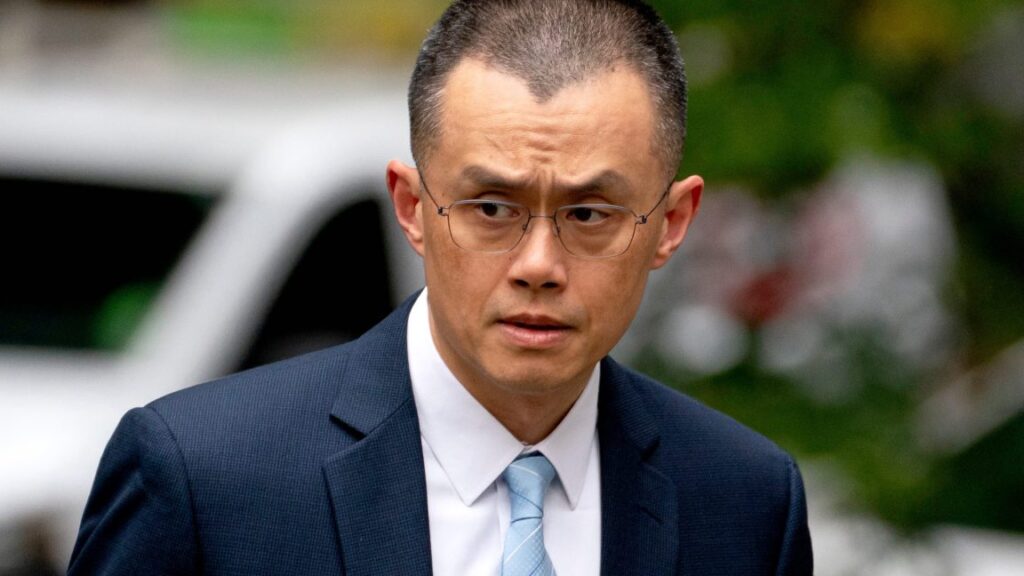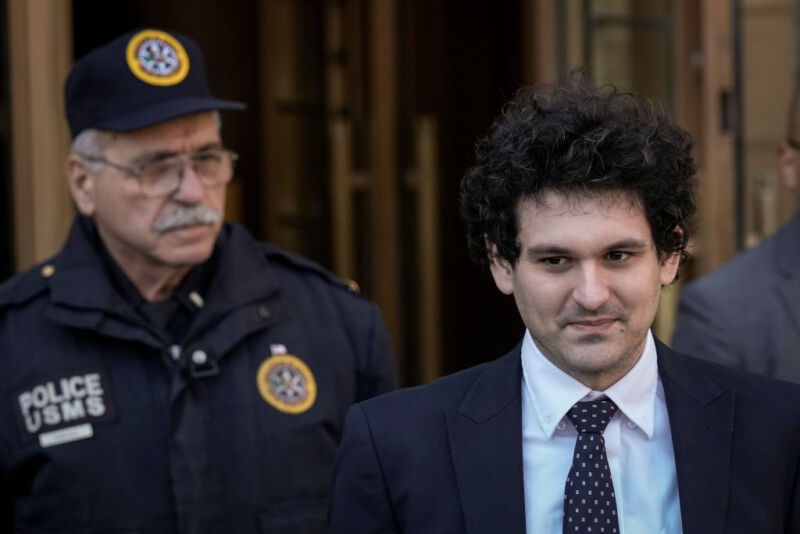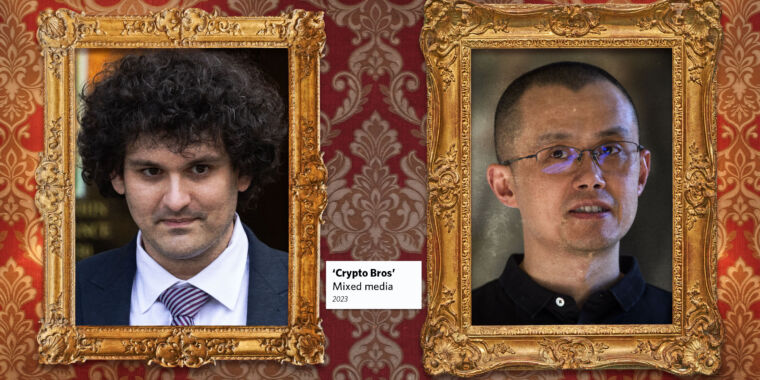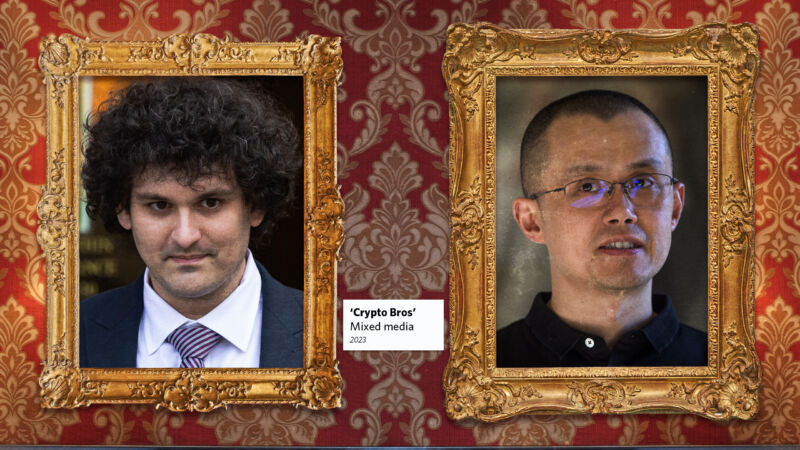FTX sues Binance for $1.76B in battle of crypto exchanges founded by convicts
Lawsuit seeks “at least $1.76 billion that was fraudulently transferred” by SBF.
Former Binance CEO Changpeng Zhao arrives at federal court in Seattle for sentencing on Tuesday, April 30, 2024. Credit: Getty Images | Changpeng Zhao
The bankruptcy estate of collapsed cryptocurrency exchange FTX has sued the company’s former rival Binance in an attempt to recover $1.76 billion or more. The lawsuit seeks “at least $1.76 billion that was fraudulently transferred to Binance and its executives at the FTX creditors’ expense, as well as compensatory and punitive damages to be determined at trial.”
The complaint filed yesterday in US Bankruptcy Court in Delaware names Binance and co-founder and former CEO Changpeng Zhao among the defendants. FTX founder Sam Bankman-Fried sold 20 percent of his crypto exchange to Binance in November 2019, but Binance exited that investment in 2021, the lawsuit said.
“As Zhao would later remark, he decided to exit his position in FTX because of personal grievances he had against Bankman-Fried,” the lawsuit said. “In July 2021, the parties negotiated a deal whereby FTX bought back Binance’s and its executives’ entire stakes in both FTX Trading and [parent company] WRS. Pursuant to that deal, FTX’s Alameda Research division directly funded the share repurchase with a combination of FTT (FTX’s exchange token), BNB (Binance’s exchange token), and BUSD (Binance’s dollar-pegged stablecoin). In the aggregate, those tokens had a fair market value of at least $1.76 billion.”
Because FTX and Alameda were balance-sheet insolvent by early 2021, the $1.76 billion transfer “was a constructive fraudulent transfer based on a straightforward application” of bankruptcy law, and an intentional fraudulent transfer “because the transfer was made in furtherance of Bankman-Fried’s scheme,” the lawsuit said.
Alameda could not fund the transaction because of its insolvency, the lawsuit said. “Indeed, as Bankman-Fried’s second-in-command, Caroline Ellison, would later testify, she contemporaneously told Bankman-Fried ‘we don’t really have the money for this, we’ll have to borrow from FTX to do it,'” the lawsuit said.
The complaint alleges that after the 2021 divestment, Zhao “set out to destroy” FTX, and accuses Binance and Zhao of fraud, injurious falsehood, intentional misrepresentation, and unjust enrichment.
Binance is far from the only entity being sued by FTX. The firm filed 23 lawsuits in the bankruptcy court on Friday “as part of a broader effort to claw back money for creditors of the bankrupt company,” Bloomberg reported. Defendants in other suits include Anthony Scaramucci and his hedge fund SkyBridge Capital, Crypto.com, and the Mark Zuckerberg-founded FWD.US.
Lawsuit cites SBF’s false statements
Ellison, who was sentenced to two years in prison, testified that Alameda funded the repurchase with about $1 billion of FTX Trading capital received from depositors, the lawsuit said. It continued:
Ellison further testified that Bankman-Fried dismissed her concerns about financial resources, telling her that, notwithstanding the need to use customer deposits, the repurchase was “really important, we have to get it done.” Indeed, as discussed below, one of the reasons Bankman-Fried viewed the transaction as “really important” was precisely because of his desire to conceal his companies’ insolvency and send a false signal of strength to the market. In connection with the share repurchase, Bankman-Fried was asked directly by a reporter whether Alameda funded the entire repurchase using its own assets, expressing surprise that Alameda could have done so given the purchase price and what was publicly known regarding Alameda’s financial resources. In response, Bankman-Fried falsely stated: “The purchase was entirely from Alameda. Yeah, it had a good last year :P” (i.e., an emoji for a tongue sticking out).
The transaction contributed to FTX’s downfall, according to the lawsuit. It “left the platform in an even greater imbalance, which Bankman-Fried attempted to cover up in a pervasive fraud that infected virtually all aspects of FTX’s business,” FTX’s complaint said. Bankman-Fried is serving a 25-year prison sentence.
Because FTX trading was insolvent in July 2021 when the Binance share repurchase was completed, “the FTX Trading shares acquired through the share repurchase were actually worthless based on a proper accounting of FTX Trading’s assets and liabilities,” the lawsuit said.
Zhao allegedly “set out to destroy”
FTX claims that once Zhao divested himself of the equity stake in FTX, “Zhao then set out to destroy his now-unaffiliated competitor” because FTX was “a clear threat to Binance’s market dominance.” Zhao resigned from Binance last year after agreeing to plead guilty to money laundering violations and was sentenced to four months in prison. He was released in September.
FTX’s lawsuit alleges that “Zhao’s succeed-at-all-costs business ethos was not limited to facilitating money laundering. Beginning on November 6, 2022, Zhao sent a series of false, misleading, and fraudulent tweets that were maliciously calculated to destroy his rival FTX, with reckless disregard to the harm that FTX’s customers and creditors would suffer. As set forth herein in more detail, Zhao’s false tweets triggered a predictable avalanche of withdrawals at FTX—the proverbial run on the bank that Zhao knew would cause FTX to collapse.”
Zhao’s tweet thread said Binance liquidated its remaining FTT “due to recent revelations.” The lawsuit alleges that “contrary to Zhao’s denial, Binance’s highly publicized apparent liquidation of its FTT was indeed a ‘move against a competitor’ and was not, as Zhao indicated, ‘due to recent revelations.'”
“As Ellison testified, ‘if [Zhao] really wanted to sell his FTT, he wouldn’t preannounce to the market that he was going to sell it. He would just sell it […] his real aim in that tweet, as I saw it, was not to sell his FTT, but to hurt FTX and Alameda,'” the lawsuit said.
The lawsuit further claims that while FTX was “in freefall, Zhao sent additional false tweets calculated, in part, to prevent FTX from seeking and obtaining alternative financing to cauterize the run on the institution by customers deceived by the tweets. Collectively and individually, these false public statements destroyed value that would have otherwise been recoverable by FTX’s stakeholders.”
Binance calls lawsuit “meritless”
On November 8, 2022, Bankman-Fried and Zhao agreed to a deal in which “Binance would acquire FTX Trading and inject capital sufficient to address FTX’s liquidity issues,” the lawsuit said. But the next day, Binance published tweets saying it was backing out of the deal “as a result of corporate due diligence.”
When Zhao agreed to the deal on November 8, he had “already been made aware of the ‘mishandled’ customer funds during his conversation with Bankman-Fried,” the lawsuit said. “This is contrary to Binance’s representation in the November 9 Tweets that he learned that fact after entering into the Letter of Intent. In addition, Zhao was also aware that the Debtors were insolvent when he entered into the Letter of Intent.”
In the 24 hours between the November 8 agreement and the November 9 tweets, “no new material information was provided to Zhao and Binance in the diligence process that would have revealed new issues” causing Binance to exit the deal, according to the lawsuit.
Binance said it will fight FTX’s lawsuit. “The claims are meritless, and we will vigorously defend ourselves,” a Binance spokesperson said in a statement provided to Ars.
The defendants also included “Does 1-1,000,” people who allegedly received fraudulent transfers in 2021 and “whose true names, identities and capacities are presently unknown to the Plaintiffs.” FTX is seeking recovery of fraudulent transfers from all defendants. FTX also asked the court to award punitive damages and find that Binance and Zhao committed fraud, injurious falsehood, intentional misrepresentation, and unjust enrichment.
FTX sues Binance for $1.76B in battle of crypto exchanges founded by convicts Read More »







